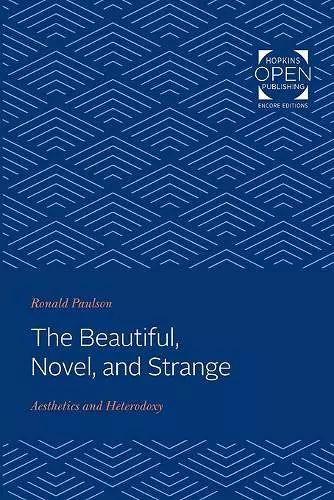The Beautiful, Novel, and Strange
Aesthetics and Heterodoxy
Format:Paperback
Publisher:Johns Hopkins University Press
Published:18th Feb '20
Currently unavailable, and unfortunately no date known when it will be back

Originally published in 1995. In The Beautiful, Novel, and Strange, Ronald Paulson fills a lacuna in studies of aesthetics at its point of origin in England in the 1700s. He shows how aesthetics took off not only from British empiricism but also from such forms of religious heterodoxy as deism. The third earl of Shaftesbury, the founder of aesthetics, replaced the Christian God of rewards and punishments with beauty—worship of God, with a taste for a work of art. William Hogarth, reacting against Shaftesbury's "disinterestedness," replaced his Platonic abstractions with an aesthetics centered on the human body, gendered female, and based on an epistemology of curiosity, pursuit, and seduction. Paulson shows Hogarth creating, first in practice and then in theory, a middle area between the Beautiful and the Sublime by adapting Joseph Addison's category (in the Spectator) of the Novel, Uncommon, and Strange.
Paulson retrieves an aesthetics that had strong support during the eighteenth century but has been obscured both by the more dominant academic discourse of Shaftesbury (and later Sir Joshua Reynolds) and by current trends in art and literary history. Arguing that the two traditions comprised not only painterly but also literary theory and practice, Paulson explores the innovations of Henry Fielding, John Cleland, Laurence Sterne, and Oliver Goldsmith, which followed and complemented the practice in the visual arts of Hogarth and his followers.
This is a remarkable and important book, one that scholars will be learning from for a long time and that critics and theorists of the arts will want to ponder for its interventions into the basic questions of aesthetics, ideology, and the relation of artistic theory and practice. It will certainly spark a much-needed debate in the complacent circles of British art history, one that will fruitfully cut across the familiar battle lines between 'left' and 'right,' 'theorists' and 'historians,' 'scholars' and 'critics.'.
—W. J. T. Mitchell, Editor, Critical Inquiry
ISBN: 9781421430560
Dimensions: unknown
Weight: 526g
394 pages